Poor Things directed by Yórgos Lánthimos, opened the main competition at this 31st edition of the Camerimage festival, where it won two prizes. This is an opportunity to offer a critical and aesthetic perspective on this singular work, the second collaboration between the Greek director and cinematographer Robbie Ryan (ISC, BSC).
Poor Things, the Golden Lion winner at the Venice Film Festival, opened the main competition at the 31st edition of Camerimage. Although, to our great regret, the film only won the Bronze Frog at Torún, this black comedy won the brand new Audience Award and the hearts of festival-goers, noted at every screening for its deliriously colourful photography, remarkable acting performances and surgically precise direction. Discovered in 2009 with the film Canine (image Thimios Bakatakis), Greek director Yórgos Lánthimos directs Emma Stone in the role of Bella Baxter.

Bella Baxter (Emma Stone) ©2023 Searchlight Pictures All Rights Reserved
The American actress is now used to the director’s rigorous standards, having worked with him in 2019 on his previous film The Favourite, and this second collaboration could well win her an Academy Award. For Irish cinematographer Robbie Ryan (ISC, BSC), who already shot The Favourite, it’s also a question of continuity and allowing the director to use his images to develop a characteristic aesthetic to depict his singular and disturbing world. Adapted several years ago from the novel of the same name by English writer Alasdair Gray, Poor Creatures is a Gothic odyssey with a cynical sense of humour. Godwin Baxter, a renowned scientist played by Willem Dafoe, carries out a bizarre experiment in the greatest secrecy: he implants the brain of a baby into the hitherto inert body of an adult woman who has taken her own life. The result of this far-fetched transplant is a heretical creature: the beautiful Bella Baxter, initially childish and naive. But Bella has a thirst for the world and is desperate to escape this surreal Victorian England. When the ingenue meets the sultry lawyer Duncan Wedderburn (Mark Ruffalo), she leaves behind Max Candless (Ramy Youssef), appointed by Professor Baxter to take part in his study. Bella embarks with her debauched new lover on an adventure that takes her to the four corners of the globe. From Lisbon, where she explores her body, to Paris, where she discovers brothels and socialism, via Alexandria, this philosophical odyssey confronts the candid creature with the world. Lánthimos borrows as much from the philosophical tale as from the gothic fable to produce a strangely fascinating film.

Robbie Ryan behind the camera. Credits: Atsushi Nishijima
CREATE A WORLD
With Poor Things, Yórgos Lánthimos is no longer content, as usual, to accentuate a few aspects of the world as we know it: he gives birth to an entire universe.
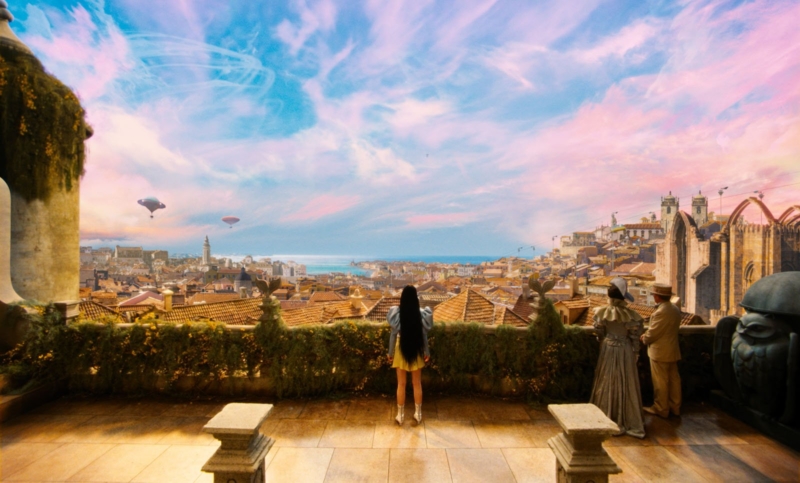 A view of Lisbon from Poor Creatures © 2023 Searchlight Pictures All Rights Reserved.
A view of Lisbon from Poor Creatures © 2023 Searchlight Pictures All Rights Reserved.
From Dogtooth (2009), in which the outside world was supposed to be non-existent, to his previous film The Favorite (2019), set in a castle in England, the Greek director has accustomed us to films that are apparently sober and minimalist, in which the drama is contained and circumscribed. Rather than appearing on screen, excess is revealed in the heightened expression of human emotions. Poor Creatures goes against this essential principle of Lánthimosian cinema, since the script no longer confines its characters to a defined space but transcribes Bella Baxter’s discovery of the world. And what a world it is! The character’s odyssey leads her to discover a diegetic space that resembles our own: it’s as if the latter had mutated after the Industrial Revolution, becoming this eccentric outgrowth that borrows as much from Victorian style and Art Nouveau as from steampunk, a sub-genre of science fiction that develops a retro-futuristic vision of the world in which steam engines and mechanics are at the heart of technical progress. In Bella’s England, hound dogs, pig geese and other hybrid animals live alongside horse-drawn steam carriages. The intersection of these different aesthetics creates a baroque space that is always saturated – saturation of objects, textures and colours.
You’ll recognise the influences of Tim Burton in the extravagance of the characters, Jean-Pierre Jeunet in the expressive use of colour and Terry Gilliam in the fantasy of the sets. The exteriors were shot in Paris and Lisbon. For the interiors, the Origo studios in Budapest (Hungary) will host the sets designed for the occasion by Shona Heath and James Price during August 2021.
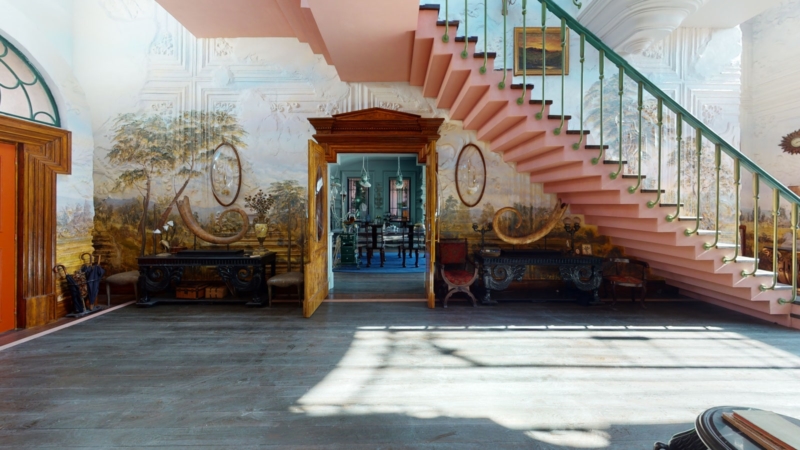
Photograph of the manor’s decor. © 2023 Searchlight Pictures All Rights Reserved.
Lánthimos creates a demiurgic echo to the figure of the mad scientist who gives birth – body – to the protagonist. Poor Things is a veritable reinterpretation of the Frankenstein myth. But Bella retains only the mechanism of the monster; although her birth – creation – remains a monstrous act in itself, there is nothing monstrous about her human appearance. On the contrary, her body quickly becomes an object of desire for the men around her, and specifically for her lover Duncan, who tears her away from the family cocoon. She hardly inherits the monstrous appearance of her father and creator, Godwin Baxter, whose protruding, almost swollen face is criss-crossed with deep scars. The FX make-up designed by Nadia Stacey gives Willem Dafoe a very special presence.
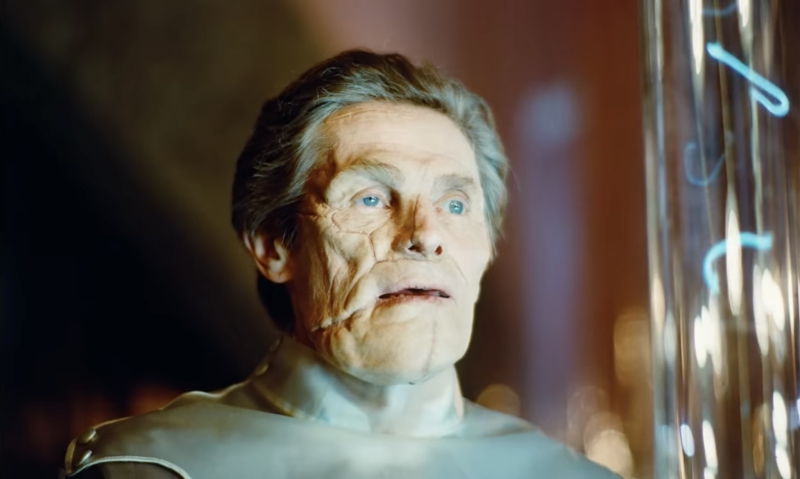
The scarred face of Godbwin Baxter (Willem Dafoe) © 2023 Searchlight Pictures All Rights Reserved.
His character admits that he himself was the guinea pig for his own father’s experiments. In Mary Shelley’s original work, Victor Frankenstein is the young scientist who gives birth to the monster; in Poor Creatures, it is Godwin Baxter’s father who is the original creative figure, thus situating Lánthimos’s reinterpretation a generation later. If God is the subject of the first F1 experiment, then Bella is the fruit of the second F2 generation, as if the new story were making a tabula rasa of previous rewrites of the Frankenstein myth, underlining the incredibly contemporary nature of a film that employs the tropes of the initiation story.

The “Bella Baxter” Experience (Emma Stone) © 2023 Searchlight Pictures All Rights Reserved.
Like Frankenstein’s monster, the figure of Bella, constantly at odds with her fellow human beings, allows us to question morality, ethics and human nature. The big blue eyes of this child protagonist cast a candid gaze on her world, questioning the ideas of otherness (the sequence in which Bella discovers the existence of the human misery of the poor of Alexandria), sadism (the dinner sequence in which the soldier takes malicious pleasure in the psychological torture of his servants) and the patriarchal order of society. This last reflection is the most far-reaching, running through the entire film. Bella’s exploration of the world and her physical, emotional and intellectual emancipation go hand in hand with her determination to escape the grip of the male figures who constantly constrain her.
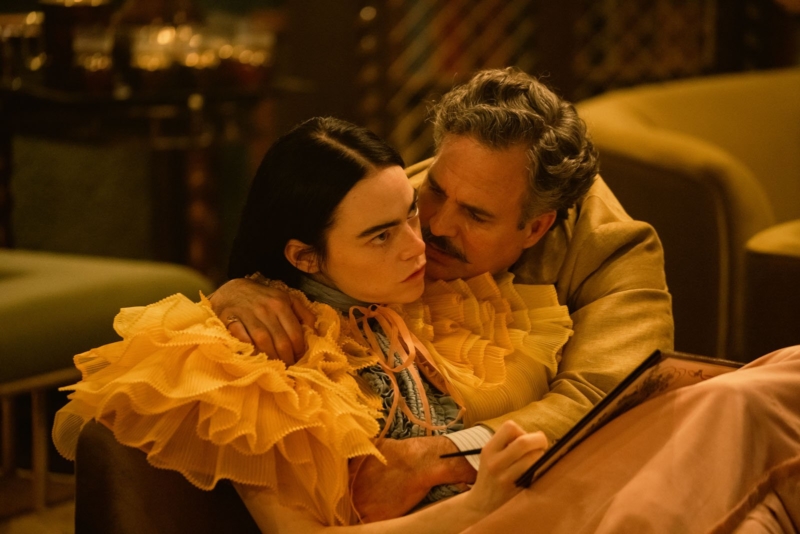
Mark Rufallo as Ducun, the debauched lover © 2023 Searchlight Pictures All Rights Reserved.
All the men seek to exert control over her; control over her body first of all, on a purely organic level, by her creator father God; control over the way this body moves and behaves in society (the sequence of the liberation of the body through dance is one of the most successful in the film); control over the way this body can enjoy its free will and freedom of movement: First she is held captive by God, then when she leaves the mansion, it is her lover Ducan who seeks to coerce her (the most telling example being the sequence where he drugs her, locks her in a trunk, before releasing her on a cruise ship whose destination she has of course not chosen); and finally, control over her sexual pleasure, over the way her very body is allowed to enjoy.
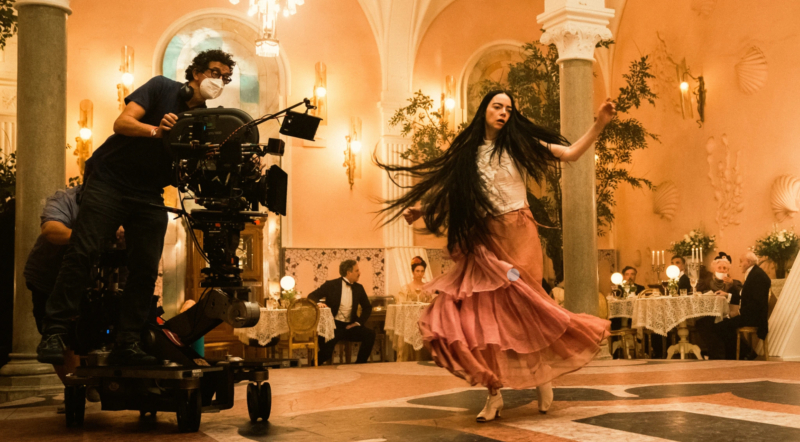
Set photograph of the dance sequence. Credits: Atsushi Nishijima
Even the development of Max McCandles, the passionate lover who first falls in love with a woman-child whom he wishes to marry, allows us to question the male attraction to a woman with a simple mind on the one hand, and marriage as a system or institution that can confine or limit women on the other. Unlike Max, whose feelings seem the most sincere, Ducan otherwise sees Bella as little more than a sex toy, and loses interest as soon as the child-woman develops her wit and knowledge (“You’re always reading now Bella, you’re losing some your adorable way of speaking.”). The question of Bella’s sexual awakening is a driving force in the narrative. During the Q&A session following the screening, a viewer commented on the way the director had managed to show a woman taking pleasure with her body without being shy, without presenting a pornographic vision of female pleasure. Willem Dafoe replied that this was largely possible thanks to the much-appreciated presence on the set of Elle McAlpine, the intimacy coordinator.
 The Discovery of Carnal Pleasures © 2023 Searchlight Pictures All Rights Reserved.
The Discovery of Carnal Pleasures © 2023 Searchlight Pictures All Rights Reserved.
Bella is created from scratch in God’s grand Victorian mansion, and although she takes her first steps on screen in the entrance hall, it is in the garden that she appears for the last time. The garden is no longer just a garden. It becomes a symbolic space when it serves as the setting for the film’s final sequence, where Bella ends her wanderings and brings the story to a close.
 |
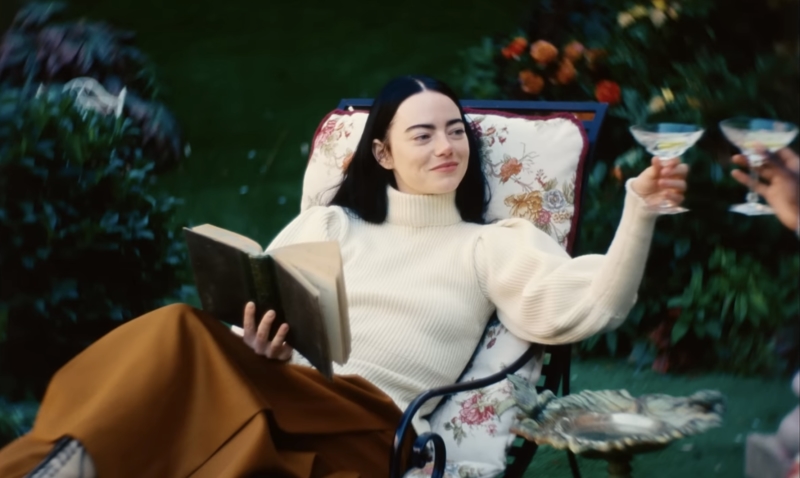 |
To complete this evocation of the biblical myth of the Garden of Eden, Lánthimos names the creative figure Godwin Baxter, allowing Bella to appropriately refer to him as “God” throughout the film. Like Voltaire’s Ingénu or Candide, Pauvres Créatures operates on the same principle as a philosophical tale, in which the various trials Bella undergoes enable her to develop her knowledge and discover philosophy through her reading, as well as being a means of questioning universal themes such as human nature, morality, ethics and the organisation of society. The film opens with a shot of tumultuous waters and closes with a shot of an open book in the garden of the manor house. God’s ‘creature’ has organised the chaos of the world into knowledge, and this last shot could be the perfect illustration of Voltairien’s conclusion “You have to cultivate your garden”. And this despite the cynicism and disillusionment with the world that comes with knowledge. At the same time, Yórgos Lánthimos concludes a film in which he has pushed his camera – since it cannot be his pen – to the limit, asserting a cinematic language all his own.
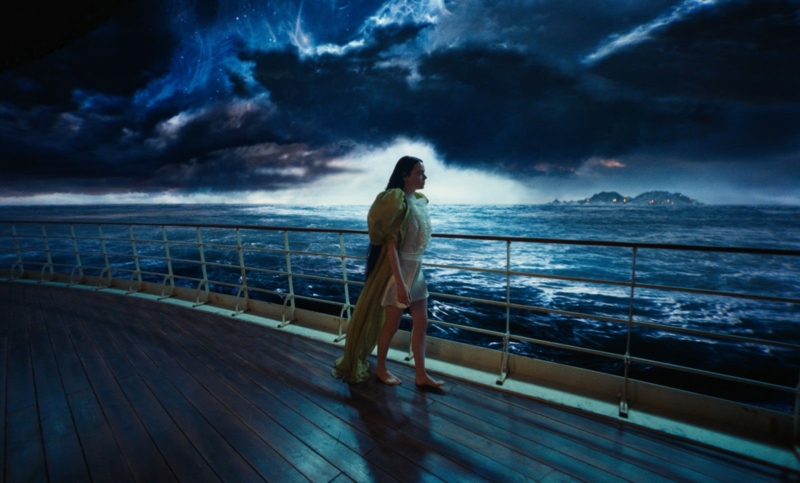
Bella on the boat © 2023 Searchlight Pictures All Rights Reserved.
CREATING A LANGUAGE
Like a fairy tale, Poor Creature is divided into chapters that follow the progression of its protagonist’s quest for initiation. But Lánthimos is not content to borrow this narrative division from literature; like Bella, who acquires language, he sets out to develop a genuine filmic language.
Since The Favourite (2019), Lánthimosian grammar has become richer and more stylistic, taking the visual experimentation undertaken by the director and his cinematographer in La Favorite a step further. “Yórgos hates the idea of an academic technical breakdown,” explains Robbie Ryan. Indeed, there is a constant alternation between two extremes. Close-ups of the faces, often below the chin, in long focus, isolating the characters, and very wide angle shots. “We […] cut the scenes with different dolly and crane movements, which, for example, start with a close-up, zoom out and then follow another character, and may even be interspersed with an extremely wide shot”. The binding material between these two extremes is the zoom, which the director wanted to introduce into the film’s cinematographic language: “Technically, integrating so many zooms into the plasticity of the visual narrative was something new for me”, admits the director of photography. Able to go from a close-up of a face to an overall shot of the set without cutting. “Yórgos wanted something that was optically really, really impossible, unfortunately. But in the end the director of photography opted for the Zeiss Master Zoom 16.5mm – 110mm.
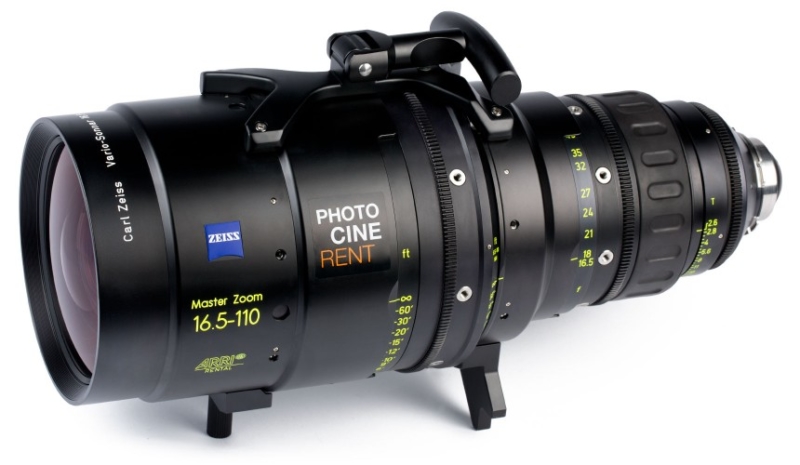
Credits: PhotoCineRent
For the entire film, he used a combination of different Nikon, Optimo Angénieux and Zeiss Master Prime lenses (which the UCO Transmission group had the opportunity to appreciate during a comparative test day last October), as well as vintage 58mm and 85mm Petzval lenses with their characteristic circular bokeh.
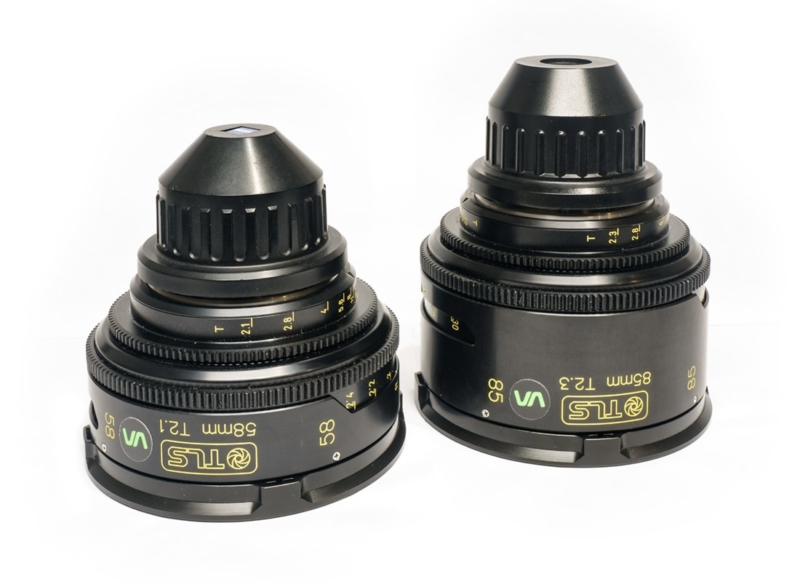
Credits: UV
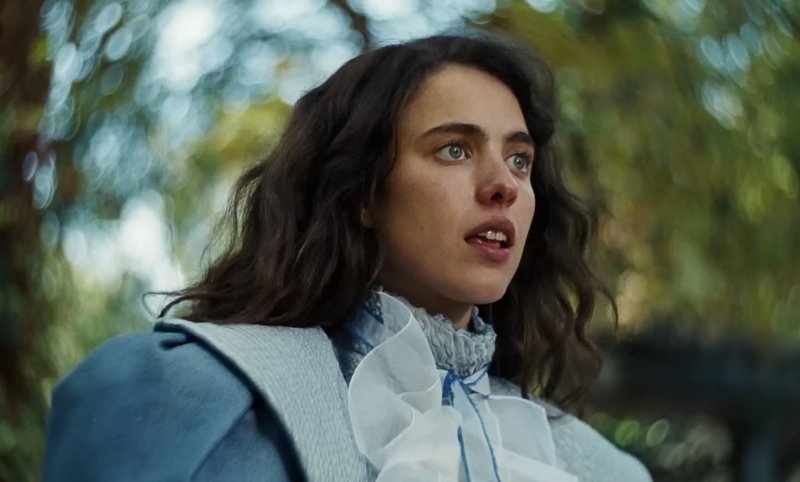
The circular bokeh of Petzval lenses © 2023 Searchlight Pictures All Rights Reserved.
For the ultra-wide angles, the director of photography used a PL Optex 4mm T2 lens. In this way, the characteristic use of the ultra-wide-angle lens is asserted in this film. It almost makes its use in The Favourite seem anecdotal, so extreme is its use here that it does not even cover the entire print area of the film. The Optex 4mm, designed to cover 16mm or S16mm, was not initially intended to cover the 35mm 4 perforations chosen to shoot the film, “but it gives a charming vignetting with black outlines, like a sort of porthole to another world, defined in the centre, with a gradual decrease in sharpness towards the outside, which Yorgos really appreciated”.
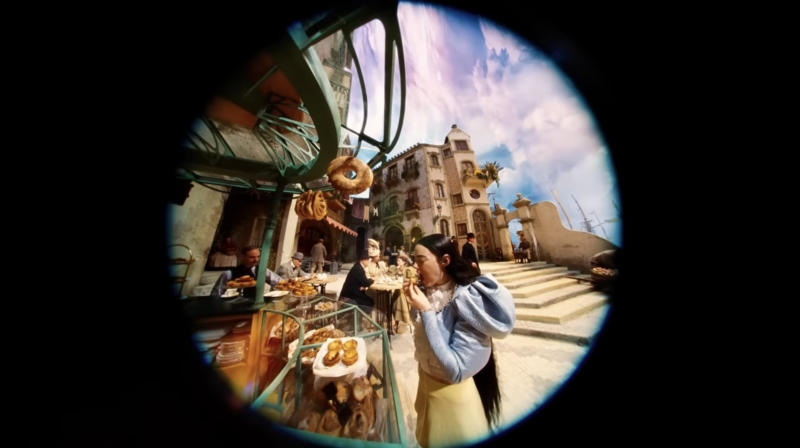
The Optex 4mm lens, designed for 16mm film on 35mm film © 2023 Searchlight Pictures All Rights Reserved.
And to avoid having spotlight stands in the angle of view, which can be very wide at any time, R. Ryan opts for soft, diffused lighting, with lots of walkable lights in the set. “I’ve probably used every Skypanel in Budapest,” he quipped during the Q&A session. Yet the image is never boring, so constantly full, expressive, saturated and organic; and owes much to the choice of shooting on Kodak Ektachrome film. Colours are rich and vibrant, blacks dense and contrasty, while flesh tones remain faithful.
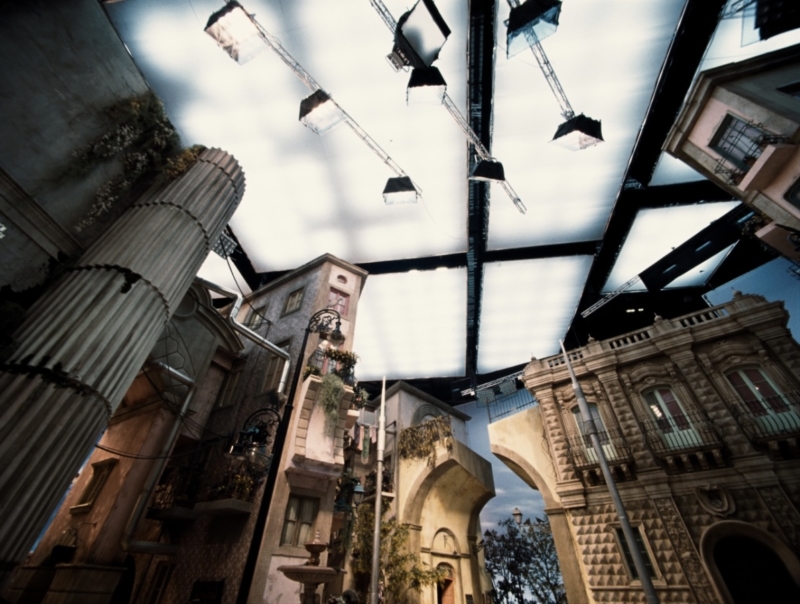
A BTS photograph from the studio © 2023 Searchlight Pictures All Rights Reserved.
Poor Creature is the first film of this scale to use 35mm Kodak Ektachrome, a positive emulsion (reversal film) developed using the E-6 process. The manufacturer reintroduced its famous emulsion in 2018, first in 16mm and Super 16mm, before producing it in 35mm in 2021. With the exception of the first colour sequence, the first part of the film is entirely in black and white; a late choice by the director, who had to convince the film’s producers. Nevertheless, Robbie Ryan confesses that this first colour segment was intended to capture the audience’s attention before falling into this contrasting black and white.
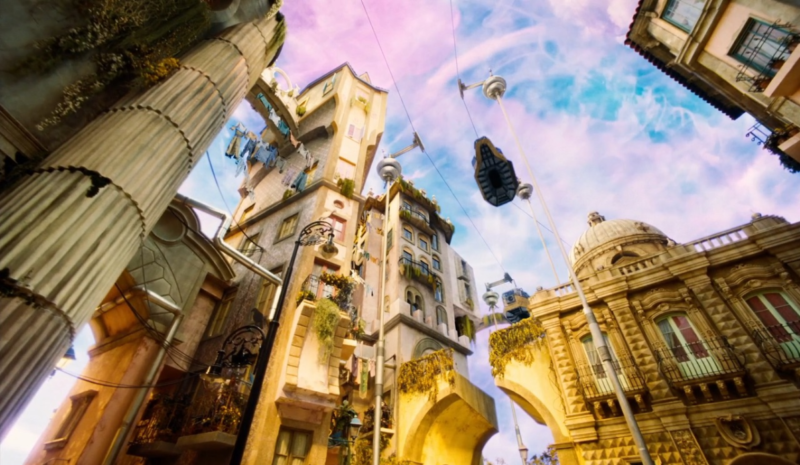
Final image © 2023 Searchlight Pictures All Rights Reserved.
The switch to colour with the Kodak Ektachrome 100D 5294 emulsion, then the Kodak Vision3 500T 5219 for the film’s denouement, follows the cold, grainy beauty of the B&W Kodak Double-X 5222 emulsion that Ryan chose. This change makes sense: the Manichean contrast of black and white, of inside and outside, of captivity and freedom, are no longer needed to explore and discover the richness of the world. Bella “brings colour to a black and white world”, adds Ryan after the screening.
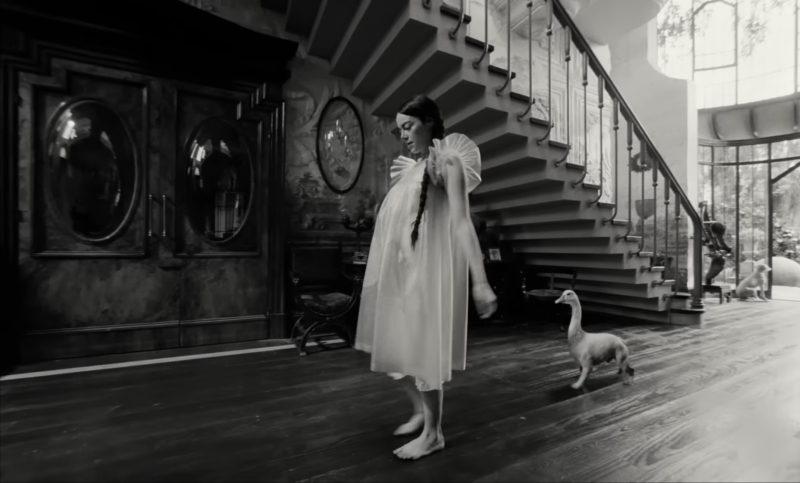
Bella in the mansion. Copyright 2023 Searchlight Pictures All Rights Reserved.
Beyond the academic film grammar one might expect from such a large American production (with a budget of 35 mio $), Lánthimos’s camerawork is very much embodied. The zooms, pans and movements of the camera in space, not always perfectly executed, all contribute to this revelation of the presence of the operator behind the camera. However, it is regrettable that this grammar does not evolve within the film itself, which could have been enriched by more than just the sudden use of colour, in line with Bella’s intellectual development. Emma Stone embodies her character remarkably well, adapting the ease of her body, her facial expressions to the development of her character. How does the Greek director direct his actors? How much space does he give them? “He doesn’t know exactly what he wants, but he knows the set-up [of the sequence]. He creates a world, and you evolve within it,” replies Willem Dafoe after the screening. “It’s the world that tells you what to do. And Robbie Ryan explains the modus operandi on the set: Lánthimos has all the tools of the trade – all the words in his language – on the set. It is by watching the sequence come to life before his eyes, through acting, that the director, with his customary acuity, chooses where to focus his attention.
The camera acts like a scalpel, cutting with dexterity. “For Yorgos, it’s a step in a new direction. He challenges himself and it shows. He’s precise,” says Ryan in the Q&A. The director of La Favorite has used the critical acclaim of his previous film to infuse his style into a production with a substantial budget. Lanthimos has produced a true object of cinema, a singular creation that leaves no one indifferent. It will be another milestone in the continuity of the filmmaker’s work and undoubtedly a gateway to his other films. The transplant is a success.



